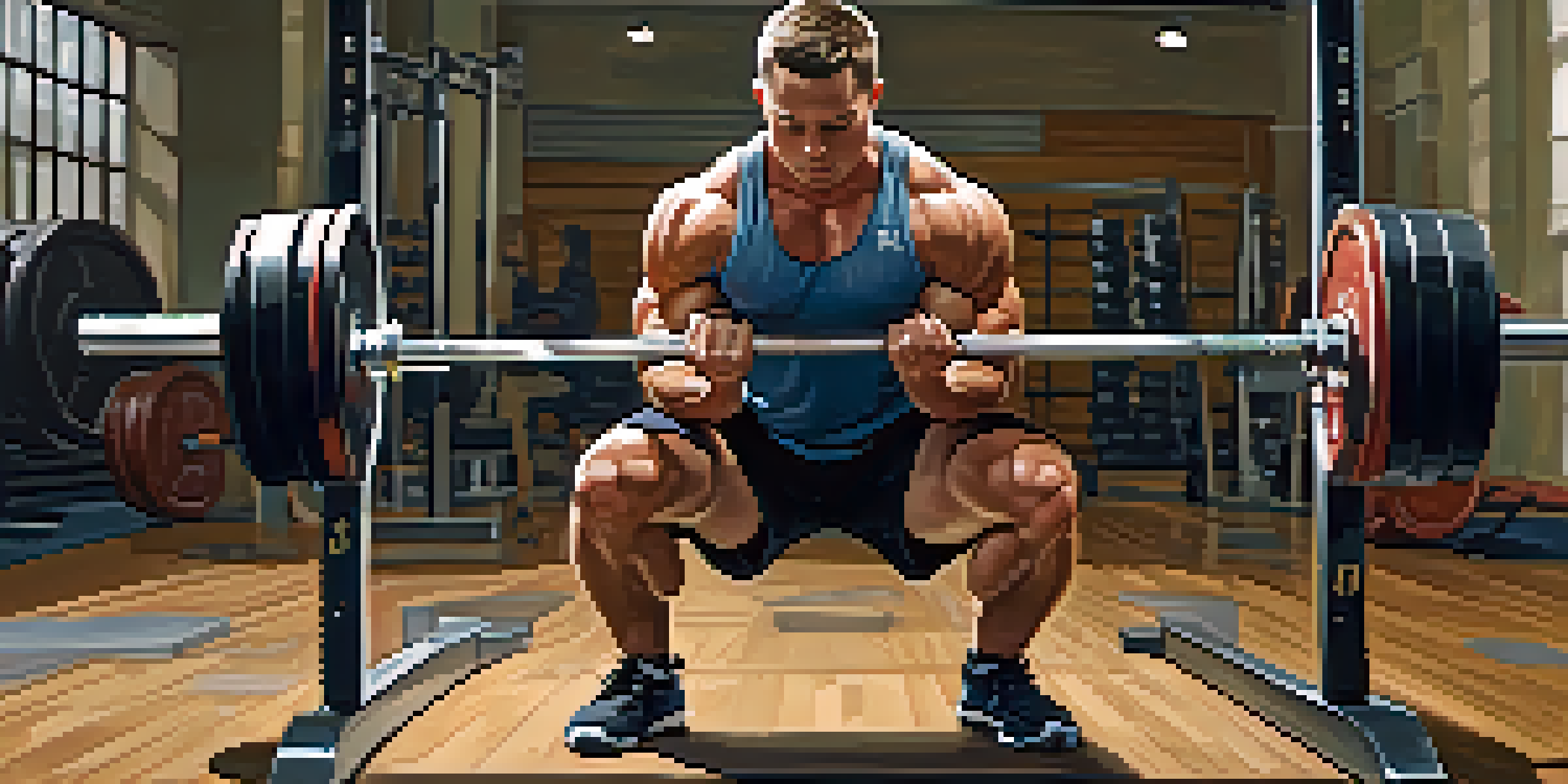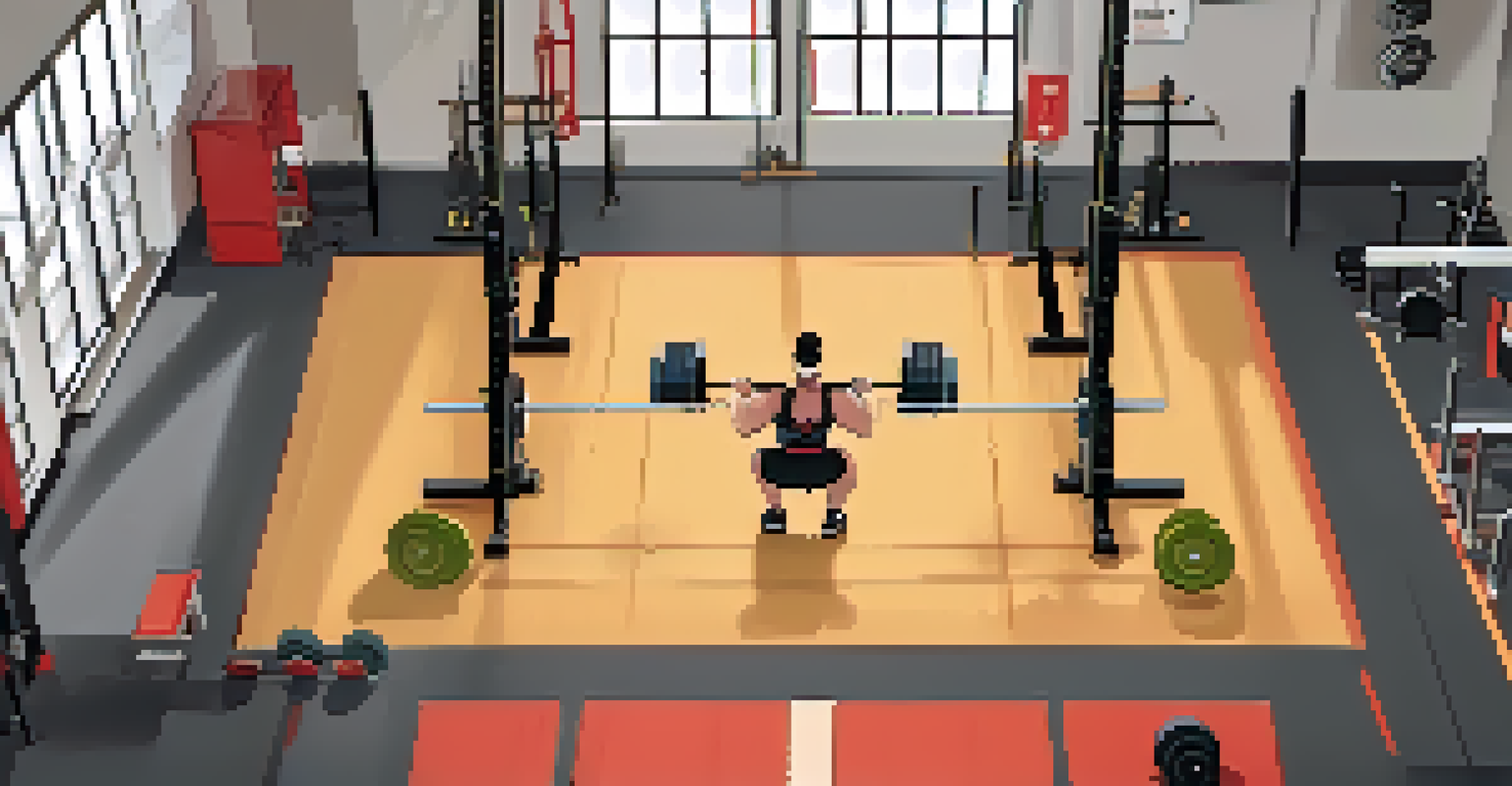How Body Mechanics Influence Powerlifting Techniques

Understanding Body Mechanics in Powerlifting
Body mechanics refer to the way your body moves and functions during various activities, including powerlifting. Proper understanding of these mechanics can significantly enhance your lifting technique and performance. It’s all about how your body aligns, balances, and uses force to lift weights effectively.
The body achieves what the mind believes.
In powerlifting, focusing on body mechanics can help prevent injuries and improve strength. For instance, maintaining a neutral spine during lifts is crucial to avoid stress on your back. By recognizing how your joints and muscles work together, you can optimize your movements for better results.
Think of body mechanics as the blueprint for your lifting strategy. Just as a skilled architect understands how to design a sturdy building, a powerlifter needs to understand their own body's structure and function. This knowledge allows for more efficient lifting and ultimately greater success in the sport.
The Role of Joint Alignment in Lifting Techniques
Joint alignment plays a pivotal role in executing powerlifting techniques correctly. When your joints are aligned properly, you're able to generate more force and lift heavier weights. For example, during a squat, having your knees tracking over your toes helps maintain balance and stability.

Misalignment can lead to compensatory movements, which not only hinder your performance but also increase the risk of injury. If your knees cave in during a squat, for instance, it places undue stress on your joints. Understanding the importance of joint alignment can help you maintain proper form throughout your lifts.
Body Mechanics Enhance Lifting
Understanding body mechanics is crucial for improving lifting technique, preventing injuries, and optimizing performance in powerlifting.
To visualize this, think of a well-constructed bridge. If the joints in the structure are aligned properly, it can support heavy traffic. Similarly, when your joints are aligned during lifting, you create a solid foundation for your body to handle heavier loads safely and effectively.
The Importance of Core Stability in Powerlifting
Core stability is essential in powerlifting, as it provides the foundation for all your lifts. A strong, stable core helps to maintain proper posture and supports your spine, making it easier to lift heavier weights. When your core is engaged, it acts like a natural weightlifting belt, protecting your lower back.
Strength does not come from physical capacity. It comes from an indomitable will.
Without adequate core strength, lifters may find themselves struggling to maintain form, especially during heavy lifts like the squat or deadlift. Weakness in this area can lead to unwanted movement patterns, resulting in injury and reduced performance. Hence, focusing on core workouts should be a priority for any serious powerlifter.
Imagine your core as the trunk of a tree; a solid trunk allows the branches to reach high without breaking. Likewise, a strong core enables you to lift more effectively and safely. By enhancing core stability, you set the stage for improved performance in all your powerlifting endeavors.
Breathing Techniques for Optimal Lifting Performance
Breathing techniques are often overlooked but are critical for optimal lifting performance. Proper breathing helps maintain intra-abdominal pressure, which stabilizes the spine during heavy lifts. This technique is especially important during maximal efforts like the squat or deadlift.
When you inhale deeply before a lift, it creates tension in your core and prepares your body for the exertion ahead. Conversely, exhaling too early can lead to a loss of stability, making it harder to lift safely. Understanding when and how to breathe can make a significant difference in your lifting technique.
Core Stability is Essential
A strong and stable core acts as a foundation for powerlifting, helping maintain proper posture and support during heavy lifts.
Think of breathing like inflating a balloon; a fully inflated balloon is firm and stable, just like your core should be during lifting. By mastering your breathing techniques, you can enhance your lifting performance and reduce the likelihood of injury, ensuring a more successful powerlifting journey.
The Impact of Foot Positioning on Lifting Efficiency
Foot positioning is a critical aspect of body mechanics that can greatly influence lifting efficiency. The angle and placement of your feet can affect your balance, stability, and overall power output during lifts. For example, a wider stance during squats can target different muscle groups compared to a narrower stance.
In powerlifting, experimenting with foot positioning can help find what works best for your unique body mechanics. Some lifters may benefit from a slightly turned-out foot position, while others may perform better with feet parallel. The key is to find a stance that allows for optimal force generation without compromising form.
Consider your feet as the foundation of a house; without a solid base, the structure cannot stand tall. Similarly, proper foot positioning provides the foundation needed for successful lifts. By paying attention to your foot placement, you can enhance your lifting technique and performance.
How Flexibility Plays a Role in Powerlifting
Flexibility is often seen as a component of fitness, but its role in powerlifting cannot be underestimated. Improved flexibility enhances your range of motion, allowing for deeper squats and better deadlifts. This increased mobility can contribute to better lifting mechanics and overall performance.
However, flexibility must be balanced with strength; too much flexibility without strength can lead to instability during lifts. It's crucial to incorporate both flexibility and strength training into your regimen to ensure optimal performance. Stretching and mobility work can prepare your body for the demands of powerlifting.
Injury Prevention through Awareness
By recognizing how your body moves and functions, you can identify weaknesses and make adjustments to prevent injuries while powerlifting.
Think of flexibility as the oil in a well-running engine; it allows parts to move smoothly and efficiently. By improving your flexibility, you create a more functional body that can handle the rigors of powerlifting, ultimately leading to better performance and reduced risk of injury.
Injury Prevention Through Understanding Body Mechanics
Understanding body mechanics is not just about enhancing performance; it's also key to preventing injuries in powerlifting. By knowing how your body moves and what it can handle, you can make informed decisions about your training. This knowledge helps identify potential weaknesses or imbalances before they lead to injury.
For instance, if you notice discomfort in your lower back during squats, it may indicate poor form or muscle imbalances that need addressing. By focusing on body mechanics, you can adjust your technique and strengthen vulnerable areas, reducing the risk of injury over time. Prevention is always better than cure.

Consider your body as a high-performance vehicle; without proper maintenance and understanding of how it operates, it’s prone to breakdowns. By investing time in understanding body mechanics, you not only enhance your performance but also ensure your longevity in the sport of powerlifting.